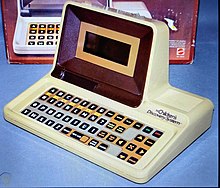
The Atari 2600 is a home video game console developed and produced by Atari, Inc. Released in September 1977, it popularized microprocessor-based hardware and games stored on swappable ROM cartridges, a format first used with the Fairchild Channel F in 1976. Branded as the Atari Video Computer System from its release until November 1982, the VCS was bundled with two joystick controllers, a conjoined pair of paddle controllers, and a game cartridge—initially Combat and later Pac-Man.

The Atari 5200 SuperSystem or simply Atari 5200 is a home video game console introduced in 1982 by Atari, Inc. as a higher-end complement for the popular Atari Video Computer System. The VCS was renamed to the Atari 2600 at the time of the 5200's launch. Created to compete with Mattel's Intellivision, the 5200 wound up a direct competitor of ColecoVision shortly after its release. While the Coleco system shipped with the first home version of Nintendo's Donkey Kong, the 5200 included the 1978 arcade game Super Breakout which had already appeared on the Atari 8-bit family and Atari VCS in 1979 and 1981 respectively.

The Commodore 64, also known as the C64, is an 8-bit home computer introduced in January 1982 by Commodore International. It has been listed in the Guinness World Records as the highest-selling single computer model of all time, with independent estimates placing the number sold between 12.5 and 17 million units. Volume production started in early 1982, marketing in August for US$595. Preceded by the VIC-20 and Commodore PET, the C64 took its name from its 64 kilobytes(65,536 bytes) of RAM. With support for multicolor sprites and a custom chip for waveform generation, the C64 could create superior visuals and audio compared to systems without such custom hardware.

Coleco Industries, Inc. was an American company founded in 1932 by Maurice Greenberg as The Connecticut Leather Company. It was a successful toy company in the 1980s, mass-producing versions of Cabbage Patch Kids dolls and its video game consoles, the Coleco Telstar dedicated consoles and ColecoVision. While the company ceased operations in 1988 as a result of bankruptcy, the Coleco brand was revived in 2005, and remains active to this day.

ColecoVision is a second-generation home video-game console developed by Coleco and launched in North America in August 1982. It was released a year later in Europe by CBS Electronics as the CBS ColecoVision.

The Intellivision is a home video game console released by Mattel Electronics in 1979. The name is a portmanteau of "intelligent television". Development began in 1977, the same year as the launch of its main competitor, the Atari 2600. In 1984, Mattel sold its video game assets to a former Mattel Electronics executive and investors, eventually becoming INTV Corporation. Game development ran from 1978 to 1990, when the Intellivision was discontinued. From 1980 to 1983, more than 3.75 million consoles were sold. As per Intellivision Entertainment the final tally through 1990 is somewhere between 4.5 and 5 million consoles sold.

The Magnavox Odyssey 2, also known as Philips Odyssey 2, is a second generation home video game console that was released in 1978. It was sold in Europe as the Philips Videopac G7000, in Brazil and Peru as the Philips Odyssey and in Japan as Odyssey2. The Odyssey 2 was one of the five major home consoles prior to the 1983 video game market crash, along with Atari 2600, Atari 5200, Intellivision and ColecoVision.

The Vectrex is a vector display-based home video game console - the only one ever designed and released for the home market, that was developed by Smith Engineering and manufactured and sold by General Consumer Electronics. It was first released for the North America market in November 1982 and then Europe and Japan in 1983. Originally produced by General Consumer Electronics, it was later licensed to Milton Bradley after they acquired the company. Bandai released the system in Japan.

The Atari 8-bit family is a series of 8-bit home computers introduced by Atari, Inc. in 1979 with the Atari 400 and Atari 800. As the first home computer architecture with coprocessors, it has graphics and sound more advanced than most of its contemporaries. Video games were a major appeal, and first-person space combat simulator Star Raiders is considered the platform's killer app. The "Atari 8-bit family" label was not contemporaneous. Atari, Inc., used the term "Atari 800 [or 400] home computer system", often combining the model names into "Atari 400/800" or "Atari home computers".
The video game crash of 1983 was a large-scale recession in the video game industry that occurred from 1983 to 1985, primarily in the United States. The crash was attributed to several factors, including market saturation in the number of video game consoles and available games, many of which were of poor quality. This along with waning interest in console games in favor of personal computers. Home video game revenues peaked at around $3.2 billion in 1983, then fell to around $100 million by 1985. The crash abruptly ended what is retrospectively considered the second generation of console video gaming in North America. To a lesser extent, the arcade video game market also weakened as the golden age of arcade video games came to an end.

The VIC-20 is an 8-bit home computer that was sold by Commodore Business Machines. The VIC-20 was announced in 1980, roughly three years after Commodore's first personal computer, the PET. The VIC-20 was the first computer of any description to sell one million units. It was described as "one of the first anti-spectatorial, non-esoteric computers by design...no longer relegated to hobbyist/enthusiasts or those with money, the computer Commodore developed was the computer of the future."

The BallyAstrocade is a second-generation home video game console and simple computer system designed by a team at Midway, at that time the videogame division of Bally. It was originally announced as the "Bally Home Library Computer" in October 1977 and initially made available for mail order in December 1977. But due to production delays, the units were first released to stores in April 1978 and its branding changed to "Bally Professional Arcade". It was marketed only for a limited time before Bally decided to exit the market. The rights were later picked up by a third-party company, who re-released it and sold it until around 1984. The Astrocade is particularly notable for its very powerful graphics capabilities for the time of release, and for the difficulty in accessing those capabilities.

The Speak & Spell line is a series of electronic hand-held child computers by Texas Instruments that consisted of a TMC0280 linear predictive coding speech synthesizer, a keyboard, and a receptor slot to receive one of a collection of ROM game library modules. The first Speak & Spell was introduced at the summer Consumer Electronics Show in June 1978, making it one of the earliest handheld electronic devices with a visual display to use interchangeable game cartridges. The company Basic Fun brought back the classic Speak & Spell in 2019 with some minor changes.

Intellivision World Series Major League Baseball is a baseball video game (1983) designed by Don Daglow and Eddie Dombrower, and published by Mattel for the Intellivision Entertainment Computer System. IWSB was one of the first sports video games to use multiple camera angles and present a three-dimensional perspective. It was also the first statistics-based baseball simulation game on a video game console; all prior console baseball games were arcade-style recreations of the sport.

The V.Smile is a sixth-generation educational home video game console manufactured and released by VTech. Titles are available on ROM cartridges called "Smartridges", to play off the system's educational nature. The graphics are primarily sprite-based. The console is often sold bundled with a particular game, with most of them having a game called "Alphabet Park Adventure." Several variants of the V.Smile console are sold including handheld versions, or models with added functionality such as touch tablet integrated controllers or microphones. The V-Motion is a major variant with its own software lineup that includes motion sensitive controllers and has Smartriges designed to take advantage of motion-related "active learning". The V-Motion and Smartridges however are fully backwards compatible with other V.Smile variants and V.Smile Smartridges, and a V-Motion Smartridge can also be played on V.Smile console or handheld, albeit with limited functionality. However, in 2010, V.Smile NEW and OLD were canceled. VTech still made games for V.Smile Pocket and V.Motion.

In the history of video games, the second-generation era refers to computer and video games, video game consoles, and handheld video game consoles available from 1976 to 1992. Notable platforms of the second generation include the Fairchild Channel F, Atari 2600, Intellivision, Odyssey 2, and ColecoVision. The generation began in November 1976 with the release of the Fairchild Channel F. This was followed by the Atari 2600 in 1977, Magnavox Odyssey² in 1978, Intellivision in 1980 and then the Emerson Arcadia 2001, ColecoVision, Atari 5200, and Vectrex, all in 1982. By the end of the era, there were over 15 different consoles. It coincided with, and was partly fuelled by, the golden age of arcade video games. This peak era of popularity and innovation for the medium resulted in many games for second generation home consoles being ports of arcade games. Space Invaders, the first "killer app" arcade game to be ported, was released in 1980 for the Atari 2600, though earlier Atari-published arcade games were ported to the 2600 previously. Coleco packaged Nintendo's Donkey Kong with the ColecoVision when it was released in August 1982.

The Intellivoice Voice Synthesis Module, commonly abbreviated as Intellivoice, is an adapter for the Intellivision, Mattel's home video game console, that utilizes a voice synthesizer to generate audible speech. The Intellivoice is a large, brown cartridge that plugs into the Intellivision's side-mounted cartridge slot; games specifically designed for the device can then be inserted into a slot provided on the right-hand side of the module.
The Entertainment Computer System (ECS) was an add-on peripheral for the Intellivision. It was Mattel Electronics' second attempt at creating a peripheral to upgrade the Intellivision into a home computer, and was rushed into production to appease the Federal Trade Commission after they began fining Mattel for false advertising following consumer complaints about the repeated delays in releasing the originally planned Intellivision Keyboard Component add-on. The ECS includes the Computer Module, Music Synthesizer, and additional hand controllers; each sold separately. Any Intellivision Master Component is compatible and a requirement to use the system. A second requirement is a cartridge plugged into the ECS, although any ECS or Intellivision cartridge will do; pressing anything on the Intellivision hand controllers will then bring up the three-option menu of BASIC, CARTRIDGE or MUSIC.
The ClickStart is an educational computer system created for children aged between 3 and 6 years by LeapFrog Enterprises and was introduced in 2007. The entire system consists of a console unit and a wireless keyboard and mouse set. It also uses cartridges, simply called My First Computer Software. The console also introduces Scout, a green-colored dog character who also appears in later LeapFrog products.

M Network was a video game division of Mattel that, in the 1980s, produced games in cartridge format for the Atari 2600 video game system.

















